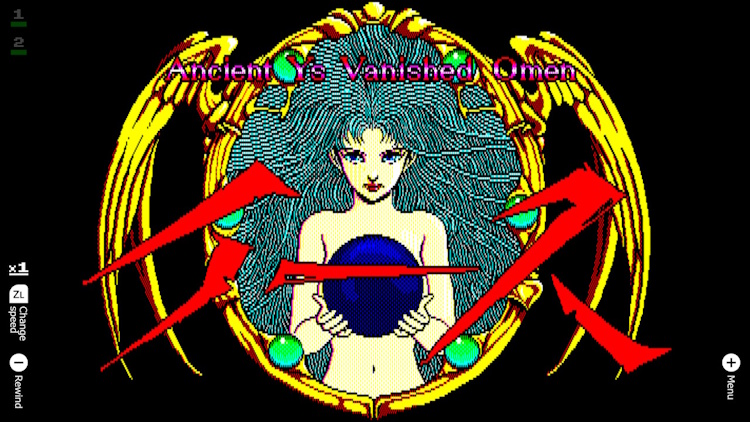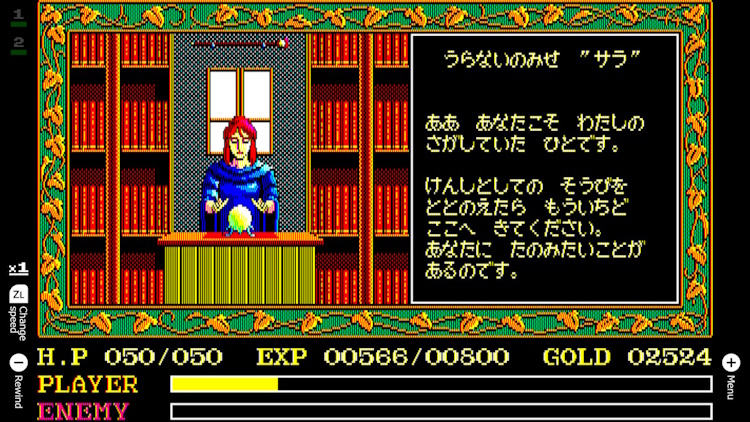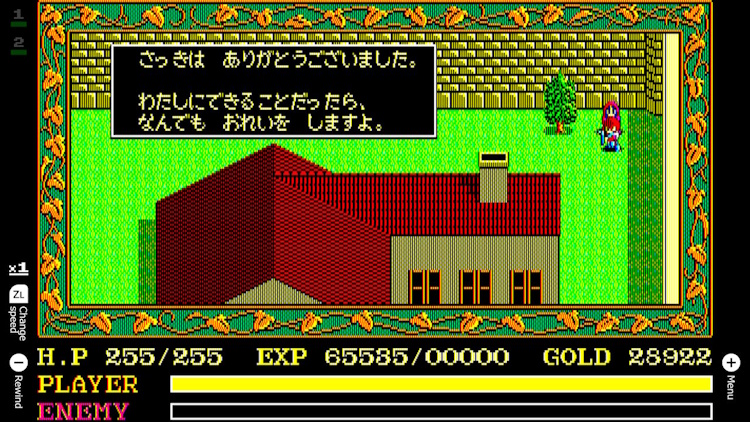

EGGCONSOLE Ys PC-8801mkIISR
Switch eShop (PC-88 emulated)
Falcom / D4 Enterprise
1987 2024
I love Ys so much it's unreal. And I'm not even talking about the series (though that has a lotta good games); I'm talking about the original ass entry. With every favorite game of mine, I typically try to experience the "original version" -- though that gets tough for something that first came out on the NEC PC-88. The two main options are either buy unwieldy and expensive hardware, or fiddle with complex emulation on the PC. Until now that is: the absolute GIGACHADS at D4 Enterprise have rereleased an emulated version of the very first iteration of Ys on the Switch, as part of their EGGCONSOLE lineup. Now, be aware that nothing on EGGCONSOLE is actually localized. This is literally the 1987 game resurrected. That said, there is an English manual and most of the game can be understood without knowing any Japanese regardless. This is especially true for anyone who's already played (and "remembered") any other version of Ys.
Ys (or Ancient Ys Vanished Omen lol) is an old-school action-RPG with a compact world (three towns, three dungeons, and a verdant overworld) and thus a relatively brief runtime. Comparisons to Zelda are obvious, though this one's roots can be traced back to older ARPGs like Hydlide and Falcom's own Dragon Slayer. The (mostly silent) protagonist is one Adol Christin, a redheaded young man with a terminal case of wanderlust. The story is rather vague. After washing ashore in a port town and awakening after a bout of unconsciousness, Adol finds himself in a land plagued by monsters. A fortune teller asks him to retrieve the titular "Books of Ys" which may divulge some secrets regarding ancient prophecies. Meanwhile, there are some smaller local matters for Adol to attend to, like the retrieval of a lost harmonica. Similar to games like A Link to the Past, there's a delightfully cryptic "mythological" background to all the events of Ys, which is something greatly expanded upon in subsequent series installments.

The big "gimmick" here is that there's no attack button; instead Adol attacks enemies automatically when he "bumps" into them. This was actually a common design element among retro Japanese ARPGs, though most of those went unlocalized which makes Ys stand out to Western gamers in this regard. Sounds simple, and success in combat is obviously level dependent. But it's also important to "aim" and thus hit enemies off-center, which is more likely to cause damage to them without harming Adol. Bosses shake things up quite a bit. They're massive and ferocious, and the game's generous save feature becomes an absolute lifesaver as deaths and reloads are inevitable. These are undeniably flawed skirmishes. Success against the earliest bosses is entirely level dependent. An underpowered Adol stands no chance, while an overpowered Adol will roll right over a boss, whereas a "perfectly leveled" Adol faces an appropriate challenge. Later bosses, once the level cap is reached, are uniformly difficult. Dozens of attempts made against a single late-game boss is not unheard of, as players must learn to guide Adol along expertly-timed shmup-like paths of precision to inflict damage without also absorbing a greater amount. Interestingly, while the game is rich with various monsters, all "normal" enemies attack in what is essentially the same fashion. That is, they attempt "bumps" of their own, and vary in terms of offensive power, defensive power, and speed. Controls feel natural on the Switch, probably better than whatever the PC-88 used!
The game's structure remains intriguing as Ys dungeons cannot be cleared in a single trip. In the first two (the palace and mines) Adol must retrieve key items (and people) from the depths, return to the surface, and later begin spelunking once again. The final dungeon, Darm Tower, literally consumes 50% of the game, a point of contention for many. Even here, Adol must bounce up and down between floors, though a net vertical progression is ultimately required. The towns themselves are pleasant. Minea serves as the "hub" of the game with its bar and various item shops, while Zeptik is used to flesh out the game's lore (Barbado doesn't appear until later remakes). NPCs are numerous and illustrated nicely. To touch on the language barrier again: it's really just the dialogue that's in Japanese. As with many old games, item names and menu options are in English (or Engrish, behold the BLUE-KNECKLESS).

As far as aesthetics go, I'm actually more surprised than anything. I expected the PC-88 to have a bit more distinct of a "look" but this really doesn't look THAT different than SMS or Famicom Ys. The visuals are simple but legible. Gameplay segments, again, recall Zelda, but those giant character portraits and floral borders exude that dreamy "left in Japan" vibe (and check out the naked grill with the orb!). And while Ys is world-renowned for its soundtrack, it's not THIS version they're talking about (the PCE red book audio is IMMACULATE). That said, the PC-88 sound chip actually rules! It's not as distinct as, say, C64 sound, but the compositions really do shine in their original form. Yuzo Koshiro, truly a master of his craft...
I gotta touch on some things unique to this EGG variant. There's (simulated) disk flipping and disk saving as well. Easy enough to figure out, but the four save state slots really come in handy, allowing saves during boss battles and so on. The "speed" of the PC-88 can be tweaked, which is hugely helpful, as Ys often feels a little too fast or too slow. Now, Adol can fly through the requisite grinding or trudge through a boss fight that demands precision hits. Now, you have to "read" the books of Ys to finish the game, after the final boss. Apparently on a real PC-88 you press the R key on the keyboard. On the Switch... it took me an embarrassingly long time to figure this out. You press the R stick. I don't like it when sticks double as buttons. Not at all. Hate that it's become standardized. The Dreamcast (final good controller) didn't do this.
Ys is so good. It has this archaic, atavistic, ruminative feeling. A je ne sais quoi that grants it an aura like it wasn't molded by human hands and somehow predates video games altogether. This original variant isn't the "definitive" one though. It's "best" on PCE and "most accessible" in Chronicles. Fans of the series (and not even necessarily obsessive ones like me) should check this out though. Bump bump bump...
Rating: 5/5
Reviewed: 11/08/25